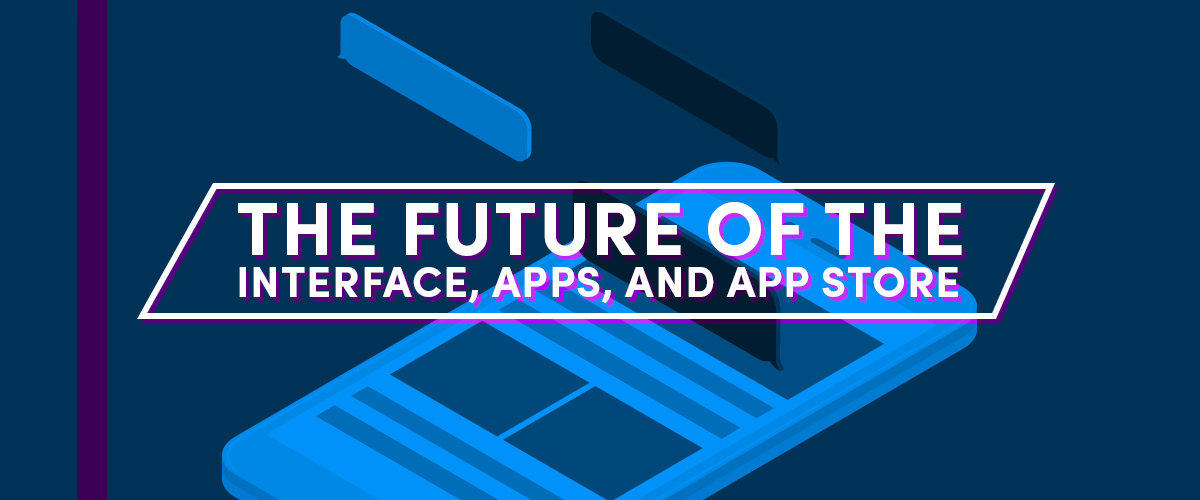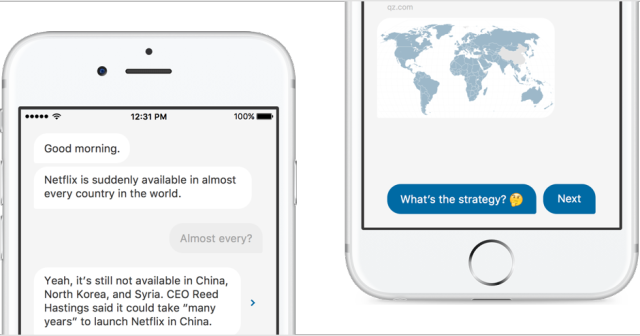
The Future of the Interface, Apps, and App Stores
Tuesday April 19th, 2016A successful interface is an "invisible" one. All interfaces will eventually become conversational and use messaging interaction patterns.
Interfaces are evolving. Since a successful interface is an “invisible” one, all interfaces will eventually become conversational and use messaging interaction patterns, ultimately controlled by voice alone.
Chat is the fastest and most versatile way to interact with any service, and right now artificial intelligence, machine learning, networks/servers, and computing power are all coming together to form the beginning stages of an interface revolution.
Sound crazy? Sound scary as a designer? Are you worried about your app?
It’s not that crazy, and don’t worry about your job or your business. Here’s a quick rundown of what’s going on, what others are doing, and how you can stay on top this change yourself.

It’s not that crazy
The first thing to understand is that it isn’t crazy to look at messaging apps as the future of all app interfaces.
Messaging apps are currently dominating Apple’s and Google’s top apps every week. Facebook Messenger, WhatsApp, WeChat, and even Slack are all examples of apps that more or less do the same things as AOL Instant Messenger from 1996 (kidding not kidding).
How is this possible? How did we come full circle?
At their core, all of the apps I mentioned are about connecting with other humans. There are reasons why each popular messaging app gained traction, but the universal key is connecting with others without interface barriers.
Each platform manages conversations, but the real meaning/purpose/connection all happens in the message content itself. Not much gets in the way or dictates the format of that conversation. Just like real life.
What will set these new conversation-based apps apart from AOL Instant Messenger is third party integrations. Today, if you wanted to talk to your friend, you might use Facebook Messenger, but if you wanted to order dinner, you’d open GrubHub or Caviar. Tomorrow, you’ll complete both tasks through the same messaging app (probably Facebook Messenger in this case).
Once services are offered within messaging apps, you can think of the chat interface as the “app store” and those third-party interactions as a new form of “apps.” In other words, as today’s apps get more singularly focused and task-specific, they will turn into bots for other apps.
Messaging apps are the new app stores. Bots are the new apps.
Actual app stores today are notoriously poor at discovery and recommendation, and the process of finding, downloading and using an app isn’t appropriate for a lot of singular-focus tasks. It’s all we know right now, but there’s a better way.
Uber recognizes this, and they’re integrating with conversation-based services like Facebook Messenger and Amazon Echo. They’re taking the bot approach and allowing users to order rides or get food delivered without using the Uber app. The public may view Uber as an app, but Uber sees themselves as a service to transport things, and they want calling a car to be as intuitive as possible.
Designers will hate this (at first)
The first reaction from most interface and visual designers is typically negative. What will happen to our jobs?! I’d argue two things. First, it will take a while to see this type of change universally, but second, there will always be interfaces to design.
We’re really focusing on a specific mobile use pattern– a person takes out their phone and wants it to be their personal assistant or a helper robot. Ask it for something; get the answer. Who cares what apps you’re using?
Besides designing non-mobile interfaces, designers will also get to focus on more nuanced aspects of the user experience for these conversational interfaces.
Take Facebook Messenger or Telegram. They both use a conversational interface, but they have features ranging from gifs and emoticons to noise level to drawing to maps to payments. All of that still needs design; we’re just not redesigning the core, chat-style interface.
App owners need to think about their offering
If you own an app, this doesn’t mean your business is over. Far from it. This is an opportunity. It would behoove you to start thinking about what parts of your services are really “app agnostic”– what can be offered via API to other services. If you start thinking this way now, you’ll be better equipped to offer integrations into other services (specifically messaging apps) in the future.
Currently, to offer your service within Facebook Messenger, you’d need to directly partner with Facebook [update: not anymore] to get the job done. However, at some point in the near future, patterns and standards for this type of interaction will start to form and self-serve platforms will open up so app owners can offer their services to other apps in bot form.
When will we see this?
Aside from the big messaging apps I mentioned, more will pop up before we start to see a few consolidate and become official platforms.
Peach is an example of an alternative messaging app that’s sprung up recently, but so is the new Quartz news app. The Quartz app isn’t actually a two way chat app. It really just gives you conversational news in message-sized chunks. You respond with one of two pre-made answers that ultimately boil down to “tell me more” or “next topic.”

Credit: Quartz
The result feels amazing. The reader is in control (or so it seems), and the content is paced like a conversation. In the future, when/if they add more machine learning, this “news bot” could start to learn individual preferences to tailor news stories or even gifs to a reader’s learned habits.
We’re also seeing a form of messaging app with Amazon Echo. I’d mention Siri, but she’s not quite as “universal” as Amazon Echo. Siri and services like Google Now certainly paved the way for the personal assistant and AI patterns we’re seeing today, but the Echo is the first product to truly master the conversational aspect of it.
Alexa (Echo’s persona) can hear and interpret commands from anywhere in a room, understand the intent, and provide an answer. Furthermore, Amazon opened up third party integrations and is sharing its machine learning with the whole ecosystem. As more services are added to Echo, it gets exponentially better for everyone.
Here’s their promo video. About half way through, you’ll start to see what I’m getting at.
This is also why I believe it will eventually be all voice-controlled. At some point, instead of typing all of our conversations, we’ll speak them. Sure we’ll have a keyboard option for private conversations, but voice will ultimately replace even the chat interface.
What about today?
The future of apps (and technology) is often right under our noses in the things we use today. With a careful eye, we can spot patterns and make predictions based on common sense and history. This is one of those predictions. Frankly, telling you this today, I’m not early to the party. A lot of people agree. At the end of this article, I’ll link to some of their ideas.
The messaging app trend comes from continually getting more technically integrated and consolidated as a species. That’s a very good thing. In the late 2000s, app stores were the first step towards consolidating a bunch of tech into a single format (the phone). Now that we’ve grown and evolved, our phones are stressful, bloated, and full of messy icons with only one or two levels of hierarchy. It’s time to consolidate again (into a single messaging interface) and regain some sanity.
Hopefully you can take this concept and apply it to your business or your offerings. Looking towards tomorrow is the only way to survive in tech, and getting early adopter advantage is sometimes enough to float a business for years.
As promised, here are few articles on this subject to learn more.
- The End of App Stores by Intercom’s Hugh Durkin
- Conversational Commerce by Uber’s Chris Messina
- The Future of Mobile Chatting: Commerce in the WSJ (paywall)
- The Future of the Messenger in Tech Crunch
- Messaging is Just Getting Started by Intercom’s Emmet Connolly
Thoughts? Questions about how this fits into your business? I’d love to chat about this! Mention me (@drewbrolik) or us (@brolik) on Twitter, or email me directly at thomasa@brolik.com.